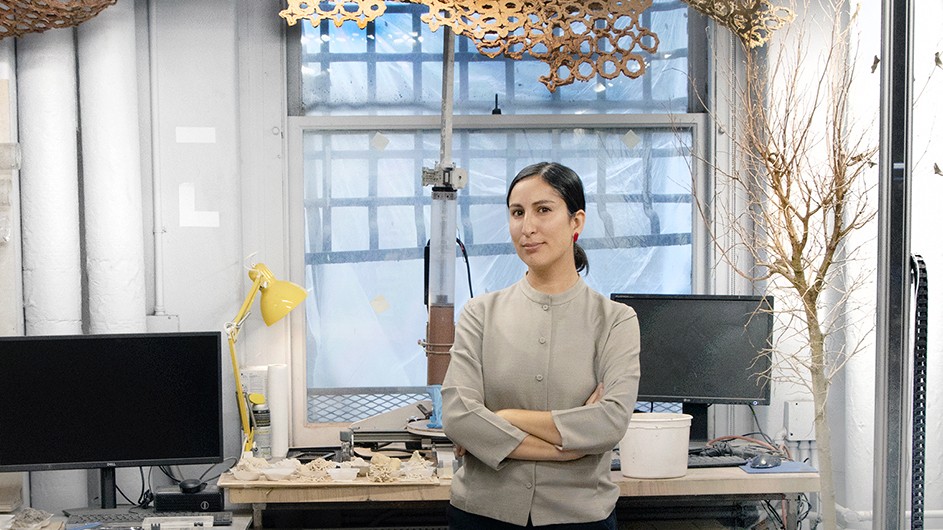Can You Use Natural Materials for Building Construction?
Yes, says GSAPP Professor Lola Ben-Alon, who is paving the way with ongoing work in the Natural Materials Lab.

Lola Ben-Alon is a professor at Columbia Graduate School of Architecture Planning and Preservation (GSAPP), where she directs the Natural Materials Lab and the Building Tech curriculum. She specializes in socially and environmentally sustainable building materials, construction practices, and engineering-architecture collaborations.
Her work focuses on natural, earth- and bio-based building materials, their manual and digital fabrication, life cycle, supply chains, and policy. She uses quantitative and qualitative methods to evaluate the embodied and operational impacts of low-carbon assemblies such as cob, rammed earth, and light straw clay.
Ben-Alon is particularly passionate about fostering connections between academia and local communities by using participatory design and social hands-on engagement in the production of the built environment. Through sharing skills and knowledge that promote healthy and affordable living environments, Ben-Alon hopes to diversify the building industry and create new interactions between architecture, engineering, art, and sociology.
Columbia News recently caught up with Ben-Alon for a conversation about her work and her students, the Natural Materials Lab, and her career path.
What is the single unifying thread that runs through your broad body of research?
The Natural Materials Lab, and my body of research at large, are focused on natural and low-carbon materials for construction. These materials—namely, earth, fibers, and bio-based additives—are defined as minimally processed (thermally- and chemically-speaking), readily available, nontoxic, and community engaged. Despite their numerous environmental, social, and low-cost possibilities, such materials are still underdeveloped in mainstream construction due to perceptual, technical, and labor intensity impediments.
My work strives to catalyze the use of these materials in upscaled as well as community-engaged applications by developing novel production modes—digital fabrication, mechanical compression, and manual craft. My work also engages in the performance characterization of these materials to enhance mix designs, durability, and to advance building policy.
If you had to pick one of the many projects in the lab as being representative of your entire output, what would it be, and why?
That's a hard question since I love all of my projects. We are currently developing a line of research that involves 3D-printed earth and fibers, and converges material science, architectural design, and installation. We use 3D printing and digital fabrication to allow new aesthetics and geometrical configurations for traditional materials and weaving patterns. By increasing the natural fiber content in 3D-printed earth, we also increase thermal performance and carbon storage.
We use wheat straw, hemp, kenaf, sisal, banana leaves, and flax fibers, mostly bi-products or agro wastes of the food and fashion industry. We also experiment with our mixtures to create wearable substances that use soils and fibers interweaved into flexible, bio-based, and fully biodegradable textiles.
We are also assessing the social life cycle of natural wall assemblies versus conventional wall systems, and modeling their thermal and hygroscopic performance.
How long has the lab been in existence?
I established the lab in the summer of 2020. Thanks to the wonderful support of former GSAPP Dean Amale Andraos, and current GSAPP Dean Andrés Jaque, plus the admin office at GSAPP, we have a new space that was launched in the summer of 2022. It's located in Schermerhorn Extension, and resides within the GSAPP Makerspace, so it's available for students to work in.
Is there an overlap between what you teach and the lab work?
Absolutely. This semester, for instance, I am teaching an elective course, "Making With Earth." This class provides both theoretical knowledge and hands-on experiences related to a range of earth-based materials and their fabrication mechanisms, including digital 3D printing, mechanical pressing, and sculptural practices. We learn about traditional techniques, such as adobe-rammed earth, cob, clay plasters, straw-bale construction, and pre-pottery soil processing, to speculate on the future of earth materials.
Students have been doing an incredible job studying earthen projects’ performance and environmental benefits in a wide range of contextual climates. The final project for this class will be presented at a gallery space, the 1014, on the Upper East Side in Manhattan on April 28 at 6:30 p.m. We plan to exhibit the students' installations and a collective lab installation. The exhibition opening will include a panel discussion that examines local material geographies, earth materials, and their support of bottom-up forms of capacity development.
Are you ever surprised by the result of an experiment in the lab, or learn something new that you didn't know before?
Yes. I am always surprised by the results of our work, since it is extremely experimental. Natural materials are variable and, sometimes, unpredictable. Also, our fabrication procedures have inherent uncertainty; a perfect computational model would always be different because we are experimenting in the lab with unknown interactions between materials and geometries. So we might design floating looping systems to examine the (hypothesized, but uncertain) printed result, using fibers and particles in the mix design.
What was your path to a career that embraces academia and experimentation?
I studied curatorial practices while getting my bachelor’s degree in civil engineering. Since then, my path has combined critical thinking with a technoscientific analytical approach. This, together with my master’s degree in construction management and a PhD in architecture, led to a strong emphasis on natural materials and their self-organized manner.